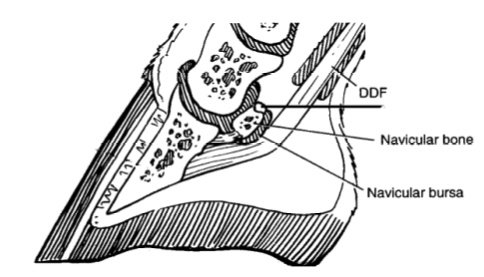Navicular Disease (2)
InfoHorse.com | 1999
Q. Mr. Smith,
My horse has been off so I had my veterinarian evaluate him. The veterinarian ccme up with a diagnosis of navicular changes. I asked him if it was navicular disease but he kind of evaded the question.
What is navicular disease?"
A. Definition: Navicular disease has been recognized since the 18th century as a cause of chronic lameness involving the front feet of horses. However, despite extensive research work and clinical observations, agreement as to the cause (etiology), the origin and development of the disease (pathogenesis) and even the diagnosis of the disease has not been reached.
Cause: There are three "true" causes of navicular disease. When diagnosed with navicular disease it appears that horses may have one or a combination of the following:
- That navicular disease is a disease where the blood supply to and/or from the navicular bone is disrupted. When the limb undergoes maximum weight bearing, the blood cannot evacuate the navicular bone rapidly, thereby setting up extreme blood pressure within the navicular bone causing pain.
- That navicular disease is a degenerative disease, similar to arthritis. Changes in the navicular bone bear considerable similarities to degenerative joint disease of the pastern and small hock joints.
- That navicular disease can be a navicular bursitis. The navicular bursa is a small fluid filled sack that lies between the deep digital flexor (DDF) tendon and the navicular bone.

It seems most likely that abnormal biomechanical stresses are the basis for the disease. This would include conformation defects, out of balance trimming and shoeing, shoeing that is not consistent with the conformation or usage of the horse, and/or standing in a "soup bowl" stall for the majority of its life.
Signs: Horses with navicular disease usually have a chronic progressive lameness, which may be intermittent in the early stages. Horses will often improve with short rest periods, only for the lameness to return when the horse resumes more frequent exercise. Owners usually complain that he horse is "off" or not moving well. The horse will land toe first and therefore have a tendency to begin stumbling.
The lameness of navicular disease is characterized by a shuffling forelimb gait, a shortened anterior phase of the stride and aggravation of the lameness upon sudden turning. If the lameness is more obvious in one of the forelegs, trotting the horse in a tight circle will aggravate the lameness when the affected leg is on the inside.
There are several conditions that mimic navicular disease and should be thoroughly investigated prior diagnosing navicular. Such problems as: chronic foot bruising (from out of balance feet), club feet or other deep flexor problems (tendonitis), P3 fractures, pedal osteitis, quarter and heel wall separation and tearing, bar cracks, corns, sheared heels, collapsed or underrun heels and horses out of anterior/posterior and or lateral/medial balance.
Treatment: Treatment falls into three categories;
- Pain alleviation
- treatment with drugs
- corrective shoeing and hoof trimming
Pain alleviation (drugs, neurectomy) and treatment with drugs are the veterinarians responsibility. You should discuss them with your vet.
Corrective shoeing and hoof trimming can be as simple as balancing the foot, putting on a shoe with the correct amount of extension, backing up a toe, egg bar shoes with or without wedge pads. Balance is the key to successfully shoeing a 'navicular horse'.
Prognosis: Prognosis is good for those horses that do not actually have navicular disease but have been diagnosed as having pain in the rear of the foot. For horses with navicular problems the prognosis is poor. Severe cases will require surgery to sever the post digital nerve. (neurectomy)